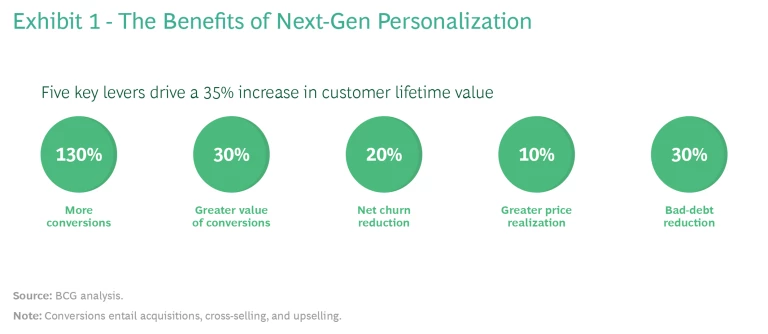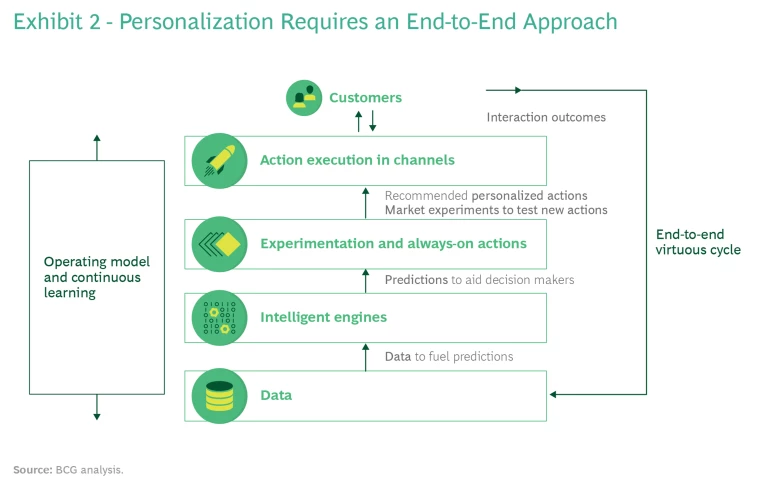Telco CMOs are often surprised to discover that when they talk personalization to their teams, they’re not always preaching to the choir.
By tailoring actions to individual customers, personalization helps telcos differentiate themselves in an increasingly competitive market. That’s a compelling proposition for both fixed and mobile operators, who are seeing less space to differentiate based purely on network and infrastructure. But when telco CMOs push for deeper personalization, they often hear a litany of objections—from their own organizations. What they are really hearing, though, are myths.
“Myth” is, of course, a strong word. And, to be sure, plenty of personalization efforts didn’t deliver the expected benefits. Many disrupted existing campaigns or required major changes to the tech stack. But in the right environment, with the right execution, all those objections CMOs are hearing simply don’t apply.
The rewards of challenging these myths can be significant. In our experience, telcos that have gone beyond one-off use cases—those that have built a foundation for scalable, hyperpersonalized actions—increased the value of their customer portfolios by 35%. (See Exhibit 1.) And they started seeing results within months, not years.
The Myths of Personalization
The key is to debunk the myths in a way that emphasizes three core ideas about successful personalization:
- Personalized actions, fueled by advanced analytics and deep customer insights, drive business impact and value.
- Scalable, modular technology is a key enabler—but not the solution itself.
- Success requires new ways of working, new roles, and (potentially) new talent.
By embedding these ideas within the organization, telcos can create—and build upon—a blueprint for customer intimacy, combining human capabilities and technical enablers to drive commercial successes in the market.
We see eight main myths holding telcos back.
“In real-world deployments, analytical models never live up to expectations.” In many cases, the problem isn’t the algorithm. The problem is the ecosystem that should be, but isn’t, surrounding it. Companies often view analytics as the solution, instead of as part of the solution. They lack an end-to-end approach. (See Exhibit 2.)
In addition to algorithms, telcos need the right data to fuel their predictive models. They need tools and processes so that agents can use the recommendations, and they need to experiment to test and refine offers. Realizing the full value of their personalization machinery requires the right operating model—one that lets them learn and improve continuously. It also takes strong change management.
We refer to this as the 10, 20, 70 rule . Companies that win with personalization typically dedicate 10% percent of their investment to algorithms, 20% to technologies, and 70% to people and processes—new ways of working that extract maximum value from those algorithms and technologies. It’s a lot to put in place. But it’s essential for realizing the full benefits of personalization and driving new, sustainable growth.
It’s also essential to understand that the personalization machinery doesn’t replace people. It enhances their performance. Algorithms excel at recognizing patterns and relationships that aren’t intuitive for humans. They weigh tradeoffs in a fast and consistent way, using a common currency—such as customer lifetime value (CLV)—to pinpoint the next best action that furthers an important goal or KPI. This lets agents tap opportunities that would otherwise fly under the radar.
It’s also essential to understand that the personalization machinery doesn’t replace people. It enhances their performance.
Similarly, humans enhance the power of the algorithms. A predictive model can crunch the data and return customer-specific recommendations. But people still play a key role. For example, an algorithm won’t explain why an offer or promotion is the right choice for a given customer. Agents need to make the recommendations resonate. The expertise of a marketing team is vital for creating the scripts and storylines that help explain why an offer makes sense. This combination of human and technical capabilities makes the magic work.
"Getting the data ready is a Herculean task.” Data is the lifeblood of personalization, and a single algorithm might require many different types of information, related to demographics, consumption, network quality, and so on. While telcos possess all this information, it’s typically captured and stored across the organization in different repositories, with varying degrees of usability, historical depth, and accessibility. Trying to bring together everything at once may not quite require the strength of Hercules, but it does require the patience of Job (and likely the wallet of Rockefeller). It’s also unnecessary.
Instead of a massive, boil-the-ocean approach to readying the data, we recommend a use-case-driven strategy. The idea is to identify a specific way personalization can create value and to pull together only the data that is relevant for that use case, effectively cleaning—and building governance around—the data that matters most. For example, one high-impact use case might be using personalization to reduce churn. Here, information about data consumption, outages, and service quality would be relevant. Data related to customers’ online behavior (to understand what they are looking for when they log in to their accounts) and their interactions with various channels (such as contact centers and physical stores) would be of further use. A savvy telco will focus exclusively on this data and how to make it available and usable for the algorithm. It’s a pragmatic, focused approach to data management and governance, one that also sets the stage for future use cases, which can tap into the processed data. Over time, a rich 360-degree view of the customer emerges.
“Having personalized, automated campaigns means handing over control to a black box.” In fact, black boxes are kryptonite to personalization. When you rely on a black box, you’re relying on a system without knowing how that system works, or having the ability to fine-tune it, whether for performance or for market or strategic shifts. Teams are unlikely to trust, or adopt, a new way of working without a clear explanation of why it’s better than the old ways they’ve followed for years. To realize the full potential of personalization, teams need to understand the models that produce recommendations and offers. They need transparency on the activity and impact of the machinery—and to be able to make adjustments on the fly.
Telcos can check these boxes by incorporating a few key elements into the personalization system. They should test algorithms in a way that readily, and visibly, demonstrates performance and reliability. One method is to backtest a model on historical data (to see if the output matches the already known result) and then assess it live in the market against a control group. And if a telco is working with an external party, cocreation—with the heavy involvement of in-house data scientists, data engineers, developers, and CRM and go-to-market experts—is essential.
By taking these steps, companies foster a greater understanding of their personalization machinery. But they also generate a mindset and culture that views—and leverages—personalization as a catalyst for growth and value.
“Market experimentation—testing offers and seeing what resonates with different segments—is of limited value. The best marketers pick up on trends before they arise.” In the digital era, expectations and behaviors are evolving faster than ever, often in unexpected ways. So, marketing experience is even more potent when it’s enhanced with an always-on system for experimentation. By leveraging automation, telcos can rapidly test new actions with specific customer segments to see what clicks. And by testing continuously, telcos are always maximizing value—even as circumstances change.
Consider how this works in practice. Say a telco wants to explore new types of offers. At the start, it will experiment with a large portion of customers to see what resonates with different segments. This lets it deliver optimized offers to the customer base. Yet a savvy telco doesn’t stop there. Following the lead of companies like Netflix and Spotify, it keeps experimenting with a subset of customers to catch the slightest change in users’ behavioral patterns, to fine-tune offers, and to test new options. We recommend aiming for a steady state where 90% of customers receive optimized offers while the other 10% receive test offers.
By leveraging automation, telcos can rapidly test new actions with specific customer segments to see what clicks. And by testing continuously, telcos are always maximizing value—even as circumstances change.
“Commercial, off-the-shelf software can handle anything we’d want to do with personalization.” Telcos that opt for a commercial package will still need to tailor it for their specific circumstances, context, and goals. That customization will likely call for specialized, often hard-to-acquire programming talent, as well as considerable time and effort. Meanwhile, opting for a commercial solution frequently means forgoing some of the flexibility that an in-house solution can provide. For example, many commercially available systems optimize for CLV, but if a company needs to change tactics and decides to optimize for a different metric (such as annual cash flow or gross adds), these systems often do not support this. Teams must then revert to manual overrides to deliver personalized results for each customer—a far cry from the automation-fueled efficiency a personalization system is expected to deliver.
Keep in mind, too, that a commercial solution will still require the same foundational work on data and algorithms. There’s no magic wand: telcos must typically provide the intelligence that feeds commercial packages, which is no trivial effort. Unsurprisingly, the balance in many cases shifts to building elements of the personalization technology in-house rather than buying these capabilities externally. Indeed, that’s proven to be a winning strategy for many personalization leaders.
“Personalization requires big changes to the tech stack before we can get started and will hinder IT’s other projects and priorities.” Big changes to the tech stack are hard to avoid—when a solution is implemented directly within a large monolithic system. But by decoupling personalization efforts from the back end, telcos can generate value rapidly without disrupting core systems. APIs and microservices allow for the deployment of minimum viable products (MVPs) in a modular fashion on top of legacy technology. So, while personalization initiatives can be integrated with the tech stack, they’re not baked in. Telcos can build their capabilities steadily—and realize benefits along the way—without a major tech overhaul. Another advantage of decoupling: the development of capabilities in a technology-agnostic way.
Personalization can’t succeed without IT’s involvement, especially if small pilots are to become big cross-company implementations. By developing MVPs, leveraging modular technologies, and testing with users (in the market for customers; internally for sales agents and other team members), companies can move quickly, minimizing the time and effort they require from IT.
In the early phases, the business can develop the building blocks for personalization: creating the intelligence models for the first use case, for example, and testing the quality of the targeting. All the while, IT and the business should communicate—and align. This enables IT to understand the value at stake and ensures the function has a clear view of what it will need to build. Accordingly, IT can more easily prioritize and plan its work.
“Even smaller personalization pilots will disrupt our business-as-usual campaigns.” By prioritizing use cases, and developing them as small pilots, companies can start benefiting from personalization without draining resources from existing activities. As the pilots scale, the benefits accrue, and telcos can gradually fold their business-as-usual activities into the new, always-on, automated campaigns. This frees up capacity for the next wave of use cases, and the process repeats.
While it may be tempting to select a new campaign for personalization, savvy telcos will often choose an existing campaign so they can reuse marketing materials and other resources. Some best practices help keep personalization efforts separate from existing business operations. Telcos should ensure that customers contacted in a traditional campaign are temporarily off limits for personalization initiatives (and vice versa). And by creating, and sticking to, a clear campaign calendar, companies can time their personalization efforts to give business-as-usual activities some breathing space.
“Scaling is a nightmare: it’s extremely difficult to move beyond pilots quickly and to make these efforts part of the standard operating procedure.” Many companies have found it difficult to scale personalization—but often they missed steps that could have eased the way.
Organizations that scale successfully tend to work in waves, piloting and scaling their highest priority use cases and steadily moving down the list. For each use case, they follow a common logic: build an MVP, test it with a subset of customers in select channels, refine it, and scale what works. Testing MVPs in the market is a particularly crucial step, as it generates value that can demonstrate—quite visibly—the power and benefits of personalization. It rallies teams behind the effort.
Strong change management is essential. Telcos must help employees embrace a new operating model and trust new processes and ways of working.
Technology helps companies go big when they scale. But telcos still need to watch out for—and avoid—potential snags. Consider, for instance, a new tool that makes recommendations to call-center agents. To get the MVP to market as fast as possible, developers may have bypassed certain tests for readiness. In the full launch of that tool, those additional tests may now be necessary to avoid problems when rolling out the tool to so many new users.
Strong change management is essential. Telcos must help employees embrace a new operating model and trust new processes and ways of working. From top management down, messaging should: encourage team members to experiment and ask for help; acknowledge the disruptive journey everyone is taking; and celebrate successes, small ones included. The idea is to make it easy for employees to accept potentially dramatic changes in how they work—and master these new ways with confidence.
Personalization creates intimacy with the customer. And in a market where product offerings are increasingly similar across players, that intimacy becomes a key differentiator and an engine for growth. But reaping the rewards requires thoughtful execution.
Every telco has its own starting point, business context, and challenges when it comes to personalization. Every telco has its own history of successes and failures, its own level of data literacy, its own tech landscape and ongoing transformation. Only by tailoring best practices to their unique environments can telcos build a sustainable advantage through personalization. To put it simply: success requires a personalized approach to personalization.















